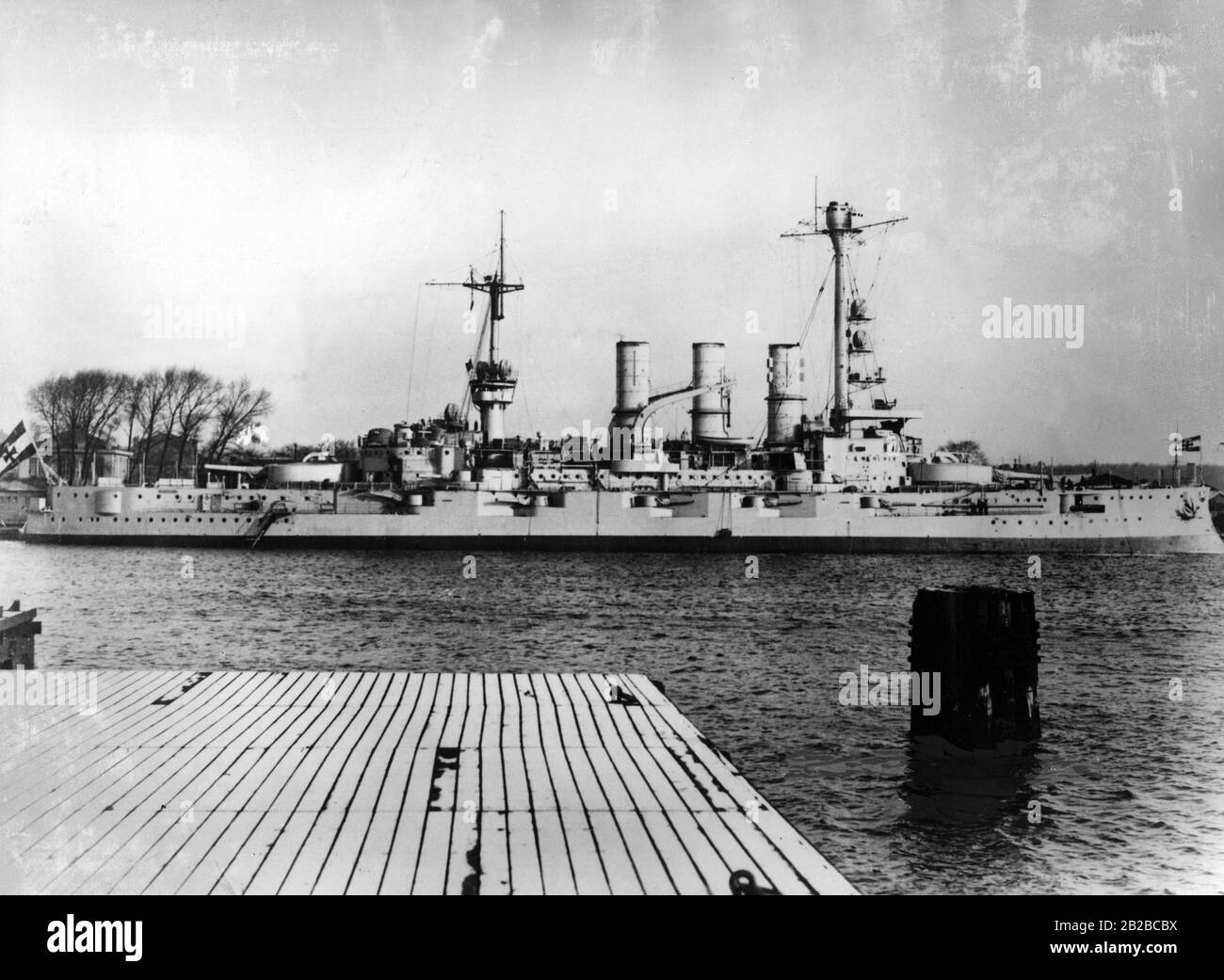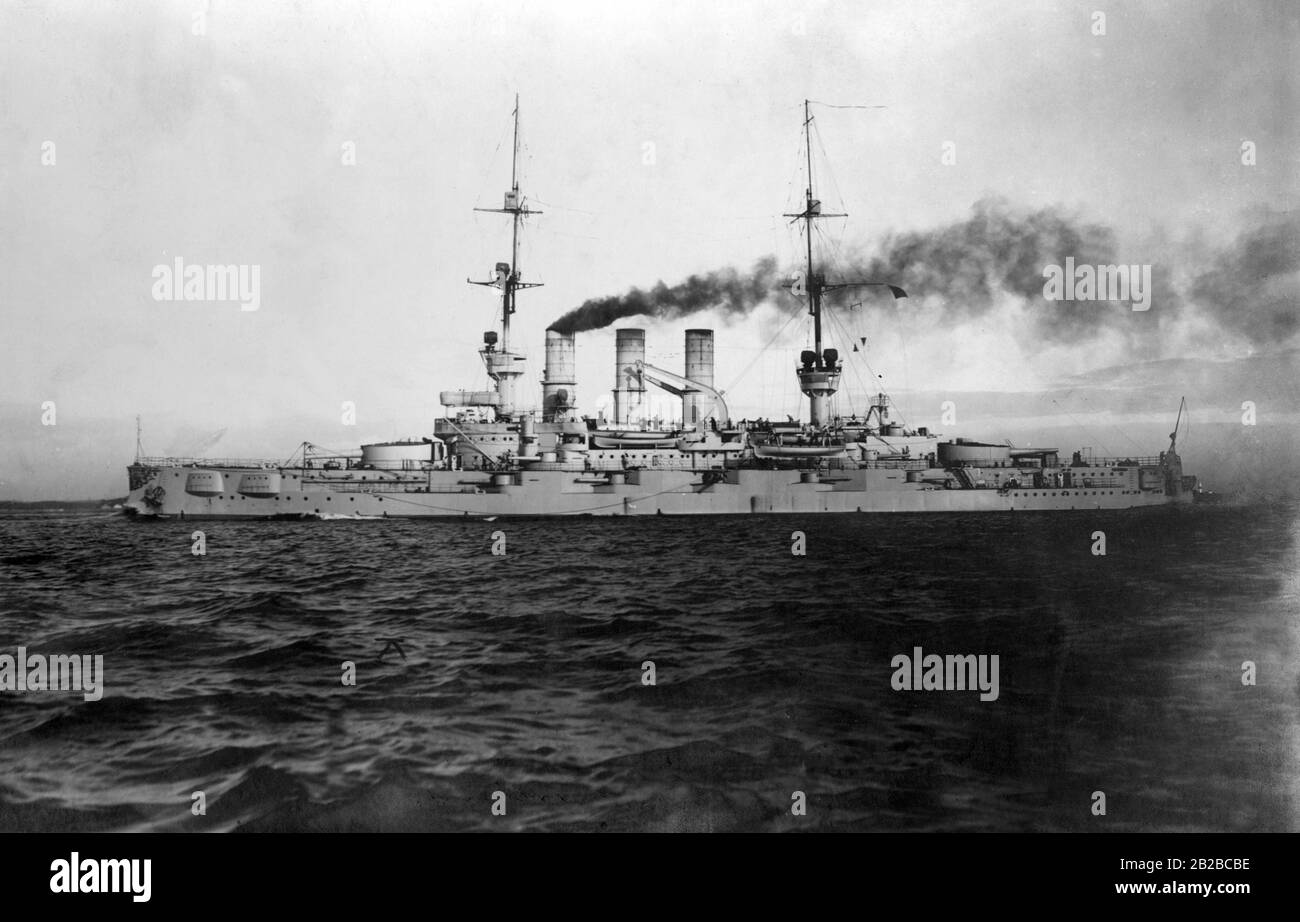Deutschland Class Battleship - The Deutschland class was a series of three Panzerschiffe (armor ships), a type of heavily armed cruiser officially built by the Reichsmarine under the restrictions imposed by the Treaty of Versailles. The Deutschland, Admiral Scheer, and Admiral Graf Spee-class ships all had a displacement of 10,000 long tons (10,160 tons) according to the Treaty, although in reality they were between 10,600 and 12,340 tons. tons (from 10,770 to 12,540 tons) in standard migration. The ship's design included several innovations, including the first major use of welding on a warship and the diesel engine. Because of the heavy armament of six 28 cm (11 in) guns and the light weight, the British began to call the ships "pocket battleships". Deutschland-class ships were originally classified as Panzerschiffe, but the Kriegsmarine reclassified them as heavy cruisers in February 1940.
These three ships were built between 1929 and 1936 by the Deutsche Werke in Kiel and the Reichsmarinewerft in Wilhelmshaven, serving the German Navy on several occasions. All three ships performed non-interventionist patrols during the Spanish Civil War. During their exploration, Germany was attacked by Republic bombers, and in response Admiral Scheer bombed the port of Almeria. In 1937, Admiral Graf Spee represented Germany at the Coronation Review of Britain's King George VI. Towards the end of her peacetime career, the fleet made a series of cruises in the Atlantic and visited many foreign ports on goodwill missions.
Deutschland Class Battleship

Before the outbreak of World War II, Germany and Admiral Graf Spee were sent to the Atlantic to attack Allied merchant shipping after war was declared. Admiral Scheer remained in port for periodic repairs. Deutschland was not particularly successful in her attack, in which she sank or captured three ships. He returned to Germany, where he was attacked by Lutzov. Admiral Graf Spee sank nine ships in the South Atlantic before engaging three British cruisers in the Battle of the River Plate. Although he damaged the British ships, he himself was damaged and his engines were in poor condition. Combined with misleading British reports of reinforcements, the ship's condition convinced Hans Langsdorff, her commander, to disband the ship from Montevideo, Uruguay.
Af8 B491 11ea 8fba 8cdcd4b147d4_1200x.jpg
Lützow and Admiral Scheer were sent to Norway in 1942 to take part in an attack on Allied convoys heading to the Soviet Union. In August 1942, Admiral Scheer carried out Operation Wonderland, a sortie in the Kara Sea to attack Soviet merchant shipping, although it ended without much success. Luttsov participated in the Battle of the Barts Sea in December 1942, the attempt to destroy the convoy was unsuccessful. Both ships were damaged while being shipped to Norway and eventually returned to Germany for repairs. They did their job bombing the advancing Soviet forces on the Eastern Front; both ships were destroyed by British bombers in the final weeks of the war. Luttsov was raised and sunk as a target for the Soviet fleet, while Admiral Scheer was badly hit in the area, and the rest of his body was buried in the debris below.
After Germany's defeat in World War I, the size of the German fleet of the Reichsmarine was limited by the Treaty of Versailles. The Navy was allowed six battleships to dreadnoughts and six light cruisers; ships could not be replaced until they were twenty years old.
To replace the battleships, new ships were moved from the area of about 10,000 long tons (10,000 t); At the time, Germany's potential rivals were limited to building ships of 35,000 long tons (36,000 t) by the Washington Naval Treaty and subsequent treaties.
Although the Naval Inter-Allied Control Commission (NIACC), created by the Treaty, had the authority to control the armament of all new warships.
Scharnhorst Class Battleships (1936)
The Allies thought that only coastal defense vessels such as those operated by the Scandinavian Navy could be built with such limitations.
The Reichsmarine's oldest battleship, the Preuss, was laid down in 1902, so it was officially replaced in 1922. Design studies were considered since 1920 with two main options: the Navy could build a very powerful, slow, and small monitor-like warship, or a large, fast, cruiser-armored light-like ship.
Actual work on the new type of gunship began in 1923, but the German economy collapsed in 1924, halting work for a while. Admiral Hans Zker, Commander-in-Chief of the Reichsmarine, strongly insisted that the navy resume design work, and three new proposals were developed in 1925. In addition to the two drawings prepared in 1923, this is a total of five different projects. In the first two designs, the I/10 was a 32-knot (59 km/h; 37 mph) cruiser armed with eight 20.5 cm (8.1 in) guns, while the II/10 was a 22-knot (41 km) / hour; 25 mph), a heavily armed ship armed with four 38 cm (15 in) guns. Three designs prepared in 1925—the "II/30", "IV/30" and "V/30"—had six 30 cm (12 in) guns with varying degrees of anti-armor. The Reichsmarine eventually chose 28 cm (11 in) guns to avoid upsetting the Allies and to reduce pressure on the design staff.

In May 1925, the Reichsmarine held a conference to test the designs, but the results were inconclusive. The most important was the long French occupation of the Ruhr industrial area, which prevented Germany from quickly creating large arms. However, the design staff produced another set of designs, the I/35, a heavily armed cruiser with a single forward triple turret, and the VIII/30, a light armored cruiser with two turrets. The Reichsmarine originally intended to lay down the first battleship in 1926, but the work was not yet complete. Maneuvers in 1926 told the design staff that greater speed was desired, and two additional designs were submitted to Zker that year.
Nelson Class Battleship: Detailed
On June 11, 1927, Zker announced that the Navy had settled on one of several proposals for new battleships. The Reichsmarine decided that the new ships would be equipped with two three turrets with 28 cm guns.
Political opposition to the new ships was great. Therefore, the Reichsmarine decided to postpone the order for the ship until the Reichstag elections in 1928.
The question of building new ships was a major issue in the election, especially with the Social Democrats strongly opposed to new ships and campaigning under the slogan "Food, not Panzerkreuzer".
In May 1928 the election was completed and a majority in favor of the new ships was elected; this included the twelve seats won by Adolf Hitler's Nazi Party. An attempt by the German Communist Party to launch a referendum against the construction in October 1928 failed. The first of the new ships was commissioned in November 1928.
German Deutschland Class Heavy Cruiser Admiral Scheer During Sea Trails.[2475 × 1418]
When the Allies heard the details of this project, they tried to prevent Germany from building it. The Reichsmarine promised to stop the construction of the first ship to enter the Washington Treaty at the rate of 125,000 long tons (127,000 t) to the 525,000 long tons (533,000 t) assigned to the British capital ship. Therefore, it would effectively end the clauses of the Treaty of Versailles that limited German military power. England and the United States encouraged the German concession, but France refused to allow any changes to the Treaty of Versailles. Since the ships did not violate the terms of the Treaty, the Allies could not prevent Germany from building them after the treaty proved unattainable.
Identify the photo of Lyutsov as it appeared in 1942. It says the armored belt is 4 inches thick instead of the original 3.1 inches.
The dimensions of the three Deutschland-type ships differed slightly. All three ships were 181.70 meters (596.1 ft) long on the waterline, with a total length of 186 m (610 ft 3 in). Deutschland and Admiral Scheer had clipper bows installed in 1940-1941; its overall length increased to 187.90 m (616 ft 6 in). Deutschland had a beam of 20.69 m (67 ft 11 in), Admiral Scheer had a beam of 21.34 m (70 ft 0 in), while Admiral Graf Spee had a beam of 21.65 m (71 ft 0 in). Deutschland and Admiral Scheer had a standard draft of 5.78 m (19 ft 0 in) and an overall draft of 7.25 m (23 ft 9 in). Admiral Graf Spee had a draft of 5.80 m (19 ft 0 in) and 7.34 m (24 ft 1 in) respectively. The displacement of three ships has increased compared to the division. Standard displacement increased from 10,600 long tons (10,800 t) in Deutschland to 11,550 long tons (11,740 t) in Admiral Scheer and 12,340 long tons (12,540 t) in Admiral Graf Spee. The ship's displacement at full load was the highest: 14,290 long tons (14,520 t) for Deutschland, 13,660 long tons (13,880 t) for Admiral Scheer and 16,020 long tons (16,280 t). t) of Admiral Graf Spee.

However, the ships were officially stated to have a capacity of 10,000 long tons (10,000 t), as required by the Treaty of Versailles.
D Class Cruiser (germany)
The ships' ships were built of transverse steel frames; more than 90% of the hulls use welding instead of conventional riveting, saving 15% of the total weight of the hull.
The boats contained twelve watertight compartments and were armed
Iowa class battleship model, montana class battleship, battleship deutschland, deutschland pocket battleship, apocalypse class battleship, german battleship deutschland, iowa battleship class, yamato class battleship, iowa class battleship museums, montana class battleship model, nelson class battleship, kongo class battleship
0 Comments